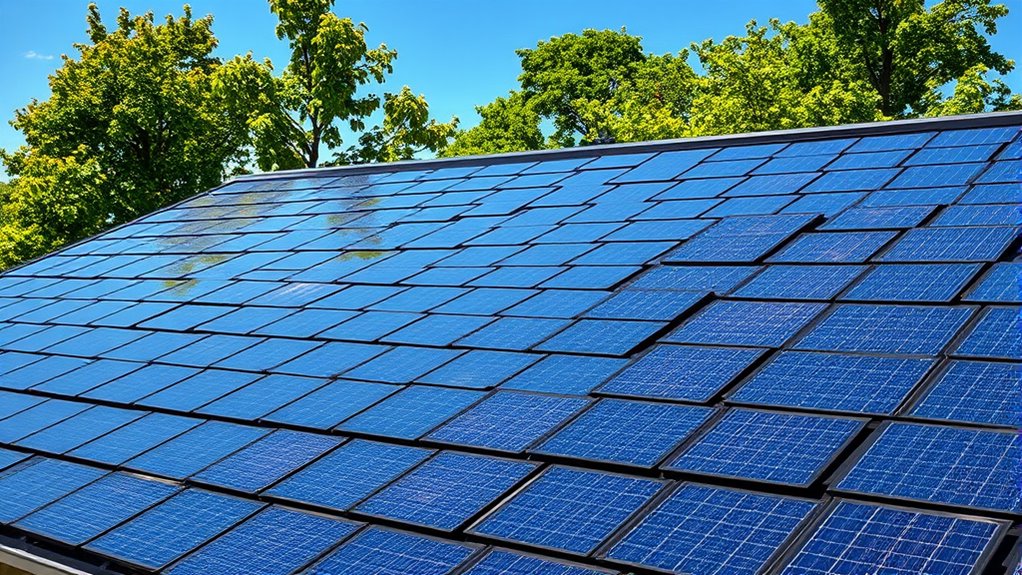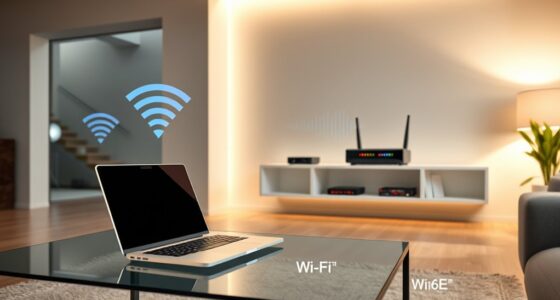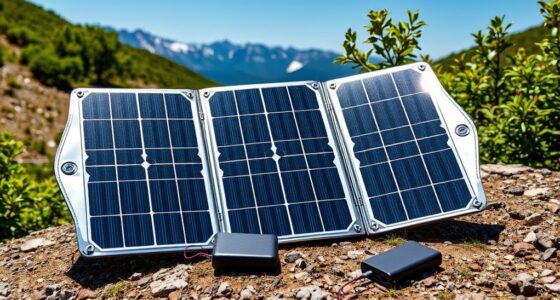Solar roof tiles offer a sleek, integrated look while generating renewable energy, making your home both stylish and eco-friendly. Made from durable tempered glass, they resist weather, impact, and UV damage, ensuring long-lasting performance. With customizable styles and colors, they blend seamlessly into your roof’s design. Advancements like smart sensors and energy storage improve efficiency and convenience. Exploring these innovative tiles reveals how they can transform your home’s aesthetic and sustainability—there’s more to discover beyond the surface.
Key Takeaways
- Solar roof tiles seamlessly blend with traditional roofing materials, enhancing home aesthetics with customizable styles and colors.
- Designed for long-term durability, they withstand harsh weather, hail, and wind, maintaining aesthetic appeal over 25+ years.
- Advanced technology offers sleek, low-profile installations that integrate photovoltaic cells without compromising visual harmony.
- Modern solar tiles incorporate smart features like sensors and energy storage, combining aesthetics with innovative functionality.
- Leading manufacturers focus on aesthetic versatility, durability, and sustainable energy production for environmentally conscious homes.
Understanding Solar Roof Tiles and Their Components
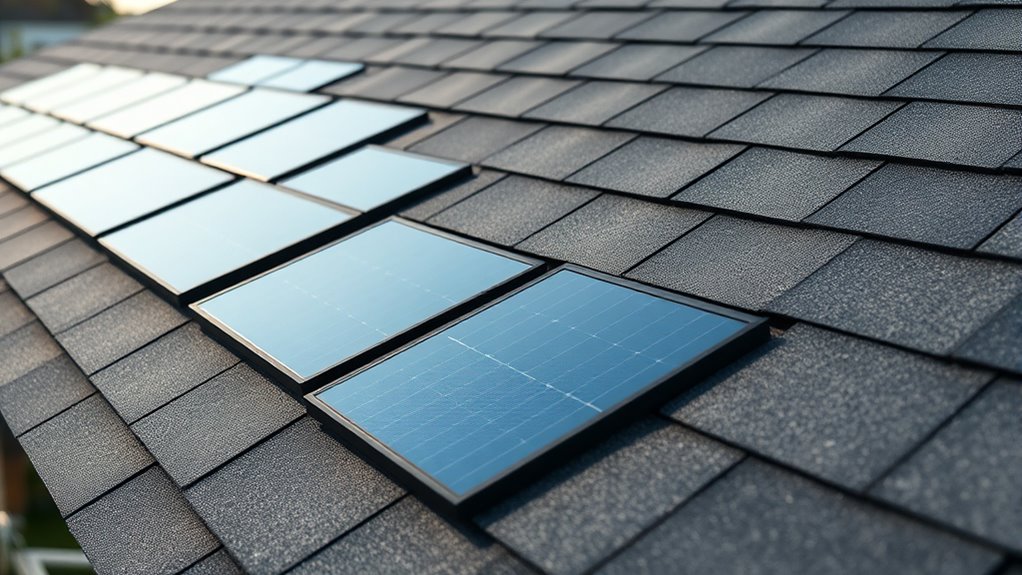
Solar roof tiles combine the look of traditional roofing materials with integrated photovoltaic (PV) technology to generate electricity. These tiles incorporate photovoltaic cells directly into their design, allowing them to serve as both roofing materials and energy producers.
Made from tempered glass, they’re highly durable and weather-resistant, capable of withstanding harsh conditions for 25–30 years. Each tile typically measures around 870 x 870 mm and produces about 110 Wp, contributing to your home’s energy generation.
The photovoltaic cells are encapsulated with EVA and protected by a moisture-resistant backsheet, ensuring long-lasting performance. Secure mounting hardware keeps the tiles in place, providing a seamless and resilient roofing solution that combines functionality with durability.
Aesthetic Benefits of Solar Roof Tiles
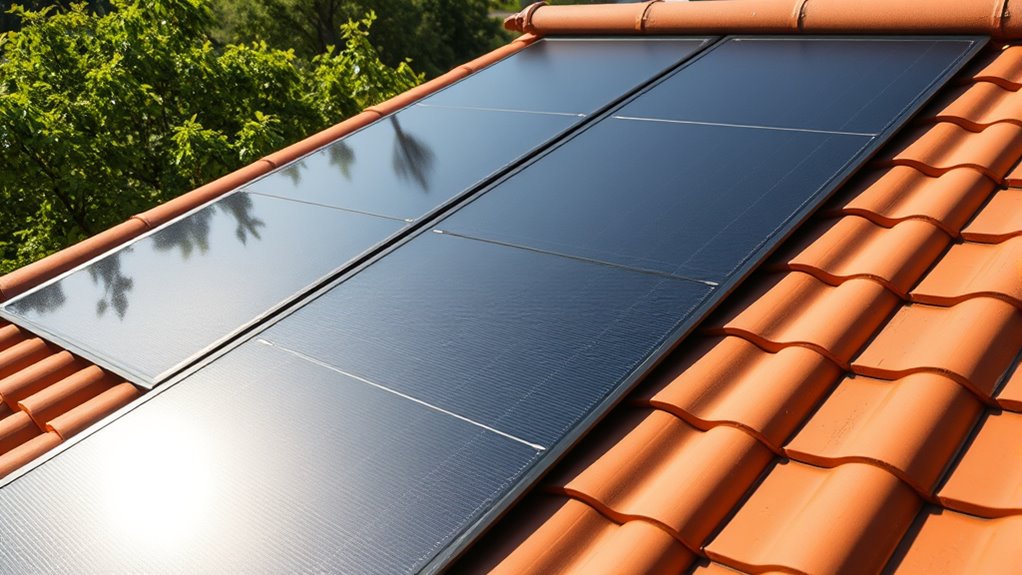
Solar roof tiles seamlessly blend with your home’s architecture, maintaining its visual charm. Their sleek, low-profile design reduces bulk while adding a modern touch. Additionally, selecting multi-functional furniture that complements the tiles can further enhance your home’s aesthetic and utility. Incorporating rustic decor elements can also create a harmonious balance between tradition and innovation. Emphasizing remote collaboration tools in planning and design phases can improve project efficiency and creativity. Considering dog-friendly design elements can make your home more welcoming for pets while preserving its aesthetic appeal. Integrating aesthetic solar solutions like solar roof tiles can elevate your home’s visual appeal while providing sustainable energy options.
Seamless Architectural Integration
Because they’re designed to blend seamlessly with traditional roofing materials, solar roof tiles enhance your home’s aesthetic appeal while generating energy. Their seamless integration maintains architectural harmony, ensuring the solar tiles design complements your roof’s style without disrupting its visual appeal. The low-profile, flush installation minimizes visual bulk, preserving the roof’s natural lines and textures. With customizable styles, colors, and textures, you can match or enhance your existing building materials, creating a cohesive look. This integration not only improves roof aesthetics but also contributes to an energy-efficient roofing system. Additionally, solar roof tiles are often rated highly for durability and weather resistance, making them a practical and stylish choice for sustainable home design. Incorporating solar technology into your roof can also increase property value, and by doing so, you support renewable energy adoption, which benefits both the environment and your community. Furthermore, leveraging innovative roofing solutions can offer long-term savings and increased resilience against weather challenges. Investing in such solutions can also help you stay aligned with home decor & design trends, ensuring your home remains both beautiful and functional.
Visual Appeal Enhancement
Integrating solar roof tiles seamlessly enhances not only your home’s energy efficiency but also its visual appeal. The aesthetic appeal of these tiles stems from their ability to mimic traditional roofing materials like slate or shingles, creating visual harmony with your architecture.
With diverse design options, including customizable colors and textures, solar tiles can complement any home exterior while maintaining a sleek, modern appearance. The seamless installation ensures a low-profile surface that preserves your roof’s curb appeal and enhances architectural integration.
Technological Advancements in Solar Tile Performance
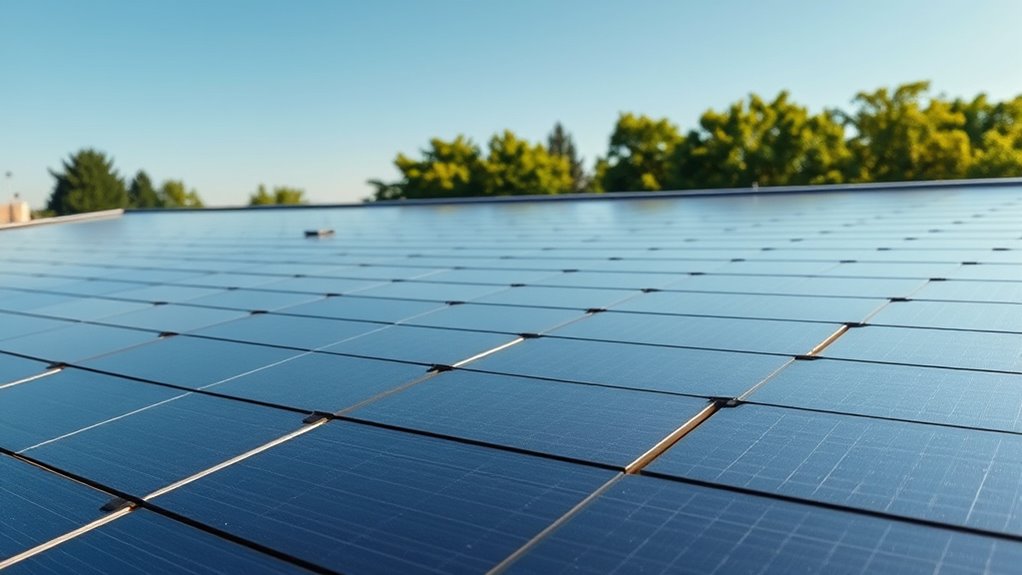
Recent advancements have markedly boosted solar tile efficiency through new materials like perovskite-silicon tandem cells, pushing performance over 30%. These innovations also enhance durability with coatings that resist UV, temperature changes, and impacts, ensuring a lifespan beyond 30 years. Additionally, integrated sensors and energy storage options are making solar tiles smarter and more self-sufficient than ever before. For optimal performance, understanding the importance of color accuracy in solar panel materials can lead to better energy conversion and visual integration with building designs. Improving material durability can further extend the lifespan and reduce maintenance costs of solar roof tiles. Incorporating long-term health benefits associated with renewable energy solutions can also motivate adoption and foster sustainable living practices. Additionally, focusing on environmental impact can highlight the broader benefits of renewable energy adoption for communities and ecosystems.
Efficiency Improvements and Materials
Have you ever wondered how solar tile technology keeps advancing? Recent innovations boost efficiency through better photovoltaic materials like perovskite and tandem cells, pushing efficiency beyond 30%. High-performance monocrystalline silicon with anti-reflective coatings and textured glass absorbs more light, reducing energy loss. Flexible thin-film materials make solar tiles more versatile and lightweight without sacrificing performance. Additionally, integrating energy storage directly into tiles using advanced thin-film batteries enhances overall system efficiency. Here’s a quick overview:
| Material Type | Efficiency Improvements | Key Features |
|---|---|---|
| Monocrystalline Silicon | 20%+ efficiency | Passivation, metallization |
| Thin-Film Materials | Versatile, lightweight | Flexibility, aesthetic design |
| Photovoltaic Technologies | 30%+ potential | Perovskite, tandem cells |
Solar tiles are also benefiting from technological advancements, which continue to drive innovation in this field.
Durability and Weather Resistance
Advances in materials and design have considerably boosted the durability and weather resistance of solar roof tiles, ensuring they can withstand harsh conditions over their lifespan. Modern solar tiles feature tempered glass and architectural-grade steel, which provide excellent impact resistance against hail and debris. Synthetic materials are increasingly used to enhance flexibility and resilience, further extending their lifespan and performance. Enhanced coatings and encapsulants improve UV resistance and corrosion protection, allowing the tiles to endure temperature fluctuations and prolonged sun exposure. Weatherproof sealing and leak-proof designs protect against water infiltration during heavy rain or storms. These solar tiles are tested for high wind resistance, often rated to withstand winds exceeding 125 mph, making them suitable for extreme weather. Incorporating local climate considerations into their design helps ensure optimal performance in diverse environments. The integration of renewable energy technology into roofing solutions exemplifies ongoing innovations in sustainable building design. Additionally, ongoing research into climate-adaptive materials aims to further improve resilience and longevity. The use of durable construction materials has become a standard in manufacturing high-performance solar tiles, contributing to their long-term reliability. Thanks to ongoing technological improvements, their long-term performance exceeds 25-30 years, maintaining durability and weather resistance throughout their lifespan.
Integration of Energy Storage and Smart Features
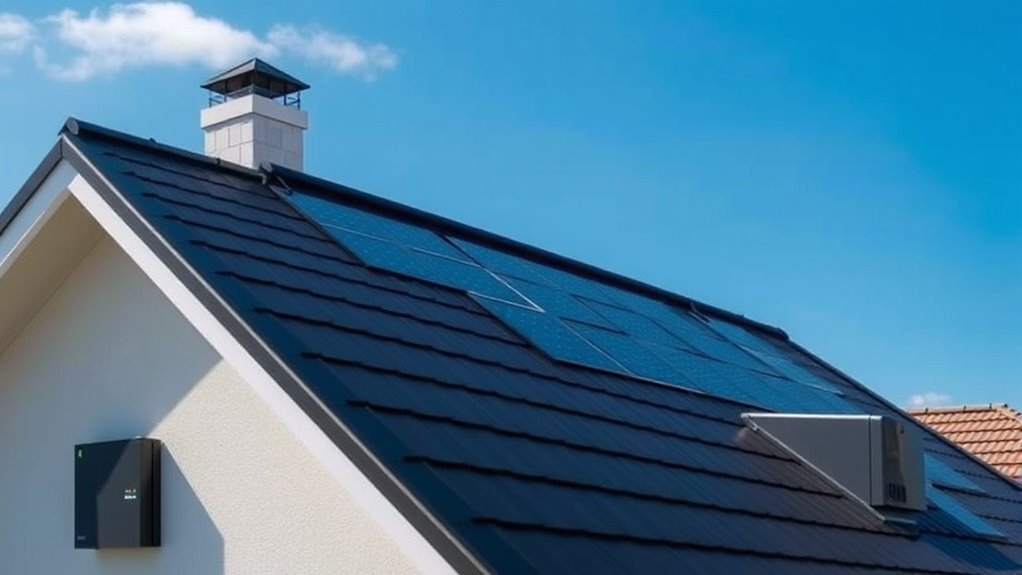
Integrating energy storage and smart features into solar roof tiles enhances their functionality and user convenience. With energy storage solutions like Powerwall, your solar tiles can provide seamless energy backup and improve overall system performance. Regular maintenance of the system ensures optimal operation and longevity. Smart features, including sensors and communication modules, monitor system health and detect maintenance issues in real time. Some solar tiles can dynamically adjust their tilt angles to maximize sun exposure throughout the day, optimizing energy generation. Embedded energy storage, such as thin-film batteries, allows for more compact and efficient energy management. Connecting your system to smart home devices enables remote control, instant alerts, and system optimization. Energy management systems can further optimize power usage by analyzing consumption patterns and adjusting operations accordingly. The integration of privacy controls ensures that user data is protected while maximizing system efficiency. These innovations make your solar roof not only aesthetically appealing but also smarter, more reliable, and energy-efficient.
Future Trends and Innovations in Solar Roofing
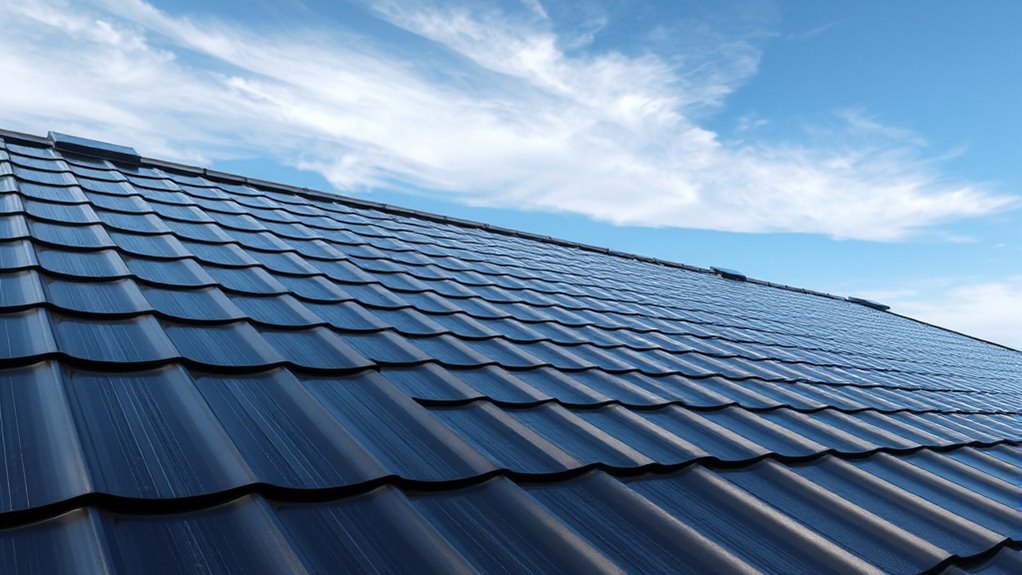
The future of solar roofing is marked by a wave of innovative technologies designed to boost efficiency and functionality. Expect solar roof tiles to reach over 30% energy efficiency with advanced materials like perovskite-silicon tandem cells. Smart tiles with integrated sensors and communication will optimize energy production and detect maintenance needs in real time. Aesthetic customization options, such as color-changing and LED-illuminated tiles, will enhance visual appeal and allow dynamic design features. Researchers are also exploring energy storage integration, like thin-film batteries embedded directly into tiles, for seamless energy management. Renewable energy integration is expected to become more streamlined as these innovations develop, leading to more sustainable urban environments. As these technological advancements continue, the accessibility of Vibe coding techniques can accelerate the development of such innovative solutions. These trends point toward broader applications, from commercial buildings to urban infrastructure. Here’s a quick overview:
| Future Innovations | Benefits |
|---|---|
| High-efficiency solar roof tiles | Increased energy output |
| Smart tiles with sensors | Real-time maintenance alerts |
| Aesthetic customization | Personalized visual appeal |
| Integrated energy storage | Seamless generation and storage |
Additionally, understanding cost management and ensuring cost-effective solutions will be crucial as these technologies are adopted widely.
Challenges and Considerations for Adoption
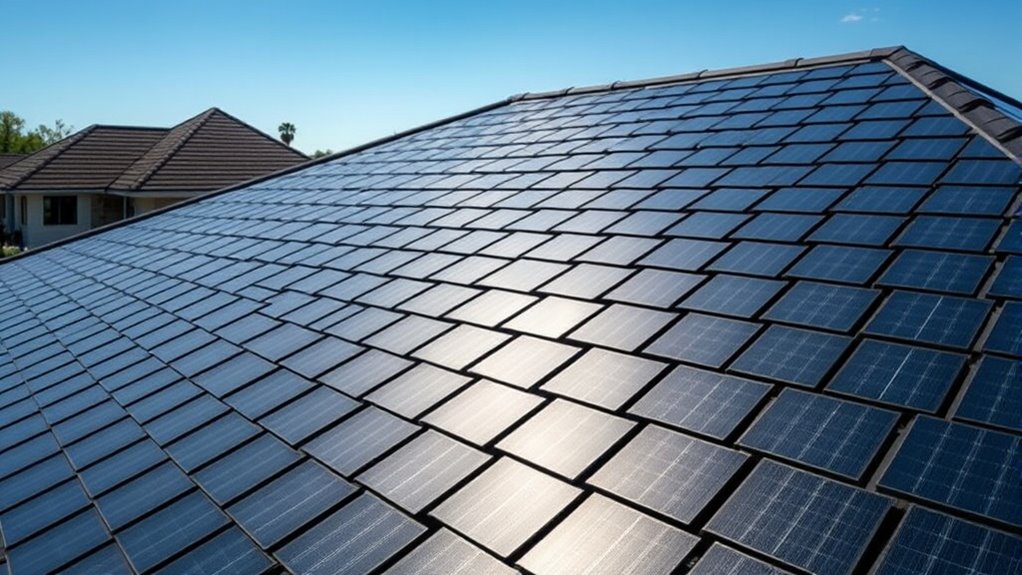
While solar roof tiles offer many benefits, their adoption faces significant hurdles. The installation costs are about 20-30% higher than traditional solar panels, which can deter potential buyers.
Installation complexity requires specialized skills and equipment, often leading to longer times and increased labor expenses. Retrofitting existing roofs with solar tiles is challenging and less cost-effective, making them better suited for new construction or full roof replacements.
Limited long-term performance data adds to consumer hesitancy, as doubts about durability and efficiency over decades remain. Additionally, the fixed angles of solar tiles may reduce overall efficiency compared to traditional panels, which can be optimized for sun exposure.
These factors collectively slow widespread adoption despite their aesthetic appeal.
Evaluating Cost, Installation, and Durability Factors
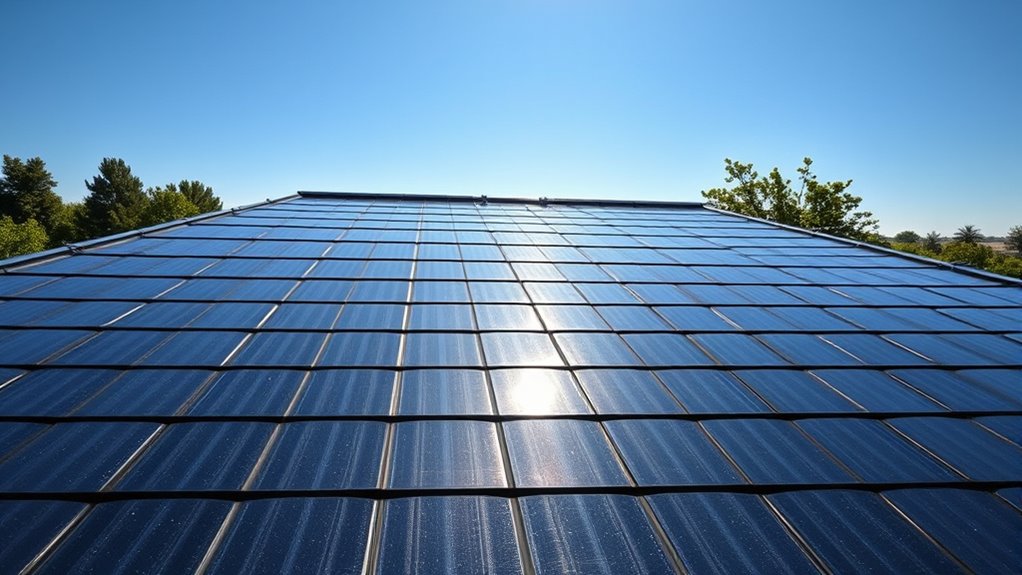
Evaluating the cost, installation, and durability of solar roof tiles reveals a mix of advantages and challenges. Solar tiles generally cost 20-30% more than traditional solar panel systems upfront, but their dual role as roofing materials can offset some expenses.
Installation is more complex and requires specialized expertise, which can increase labor costs. Retrofitting existing roofs with solar tiles is difficult, making them better suited for new constructions or roof replacements.
Durability is proven with warranties up to 25 years, yet environmental conditions like hail, snow, and high winds may impact performance. While current costs are higher, advancements in manufacturing and efficiency promise future reductions.
Leading Manufacturers and Their Offerings
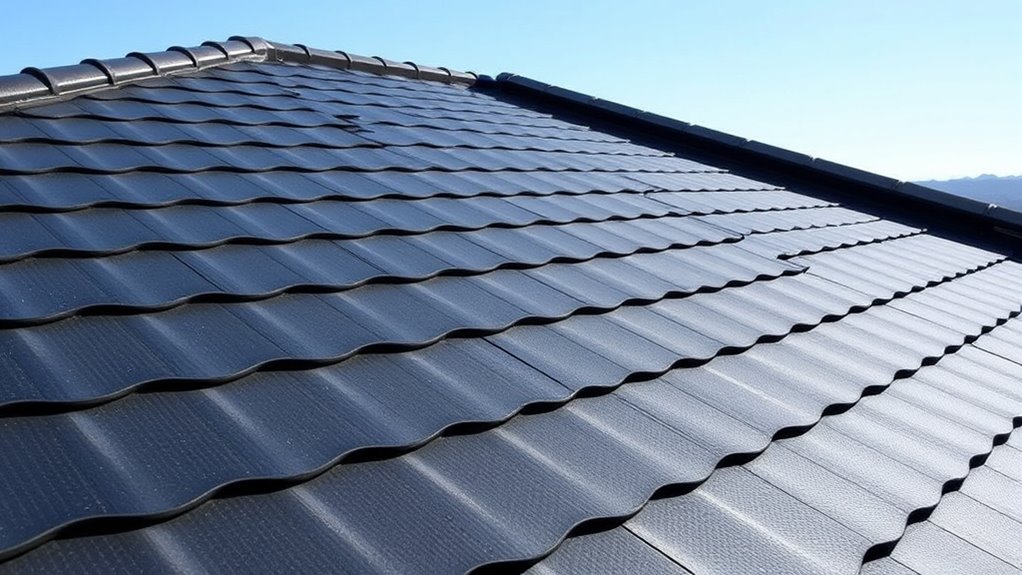
Leading manufacturers in the solar roof tile market offer a diverse range of innovative solutions tailored to different aesthetic and performance needs.
Tesla Solar Roof provides fully integrated glass and steel solar tiles with a 25-year warranty, combining sleek design with high efficiency.
Mose Solar specializes in durable, high-efficiency solar tiles that merge modern technology with architectural style, supporting seamless installation.
SunTegra offers customizable solar tiles designed for easy installation and compatibility with various roofing styles, enhancing aesthetic appeal.
Exasun’s X-Tile system features monocrystalline solar tiles with a sleek appearance and modular design, allowing scalable renewable energy solutions.
Systovi and Romag focus on building-integrated photovoltaic options, broadening design choices for different architectural preferences and optimizing solar roofing performance.
Building a Sustainable and Stylish Energy Future
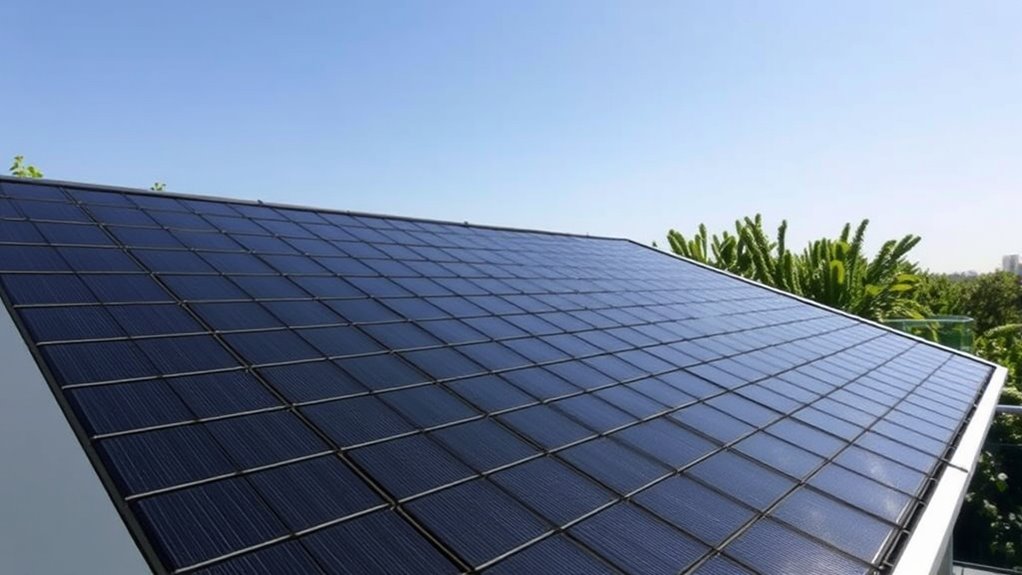
Building a sustainable and stylish energy future is increasingly possible as solar roof tiles blend seamlessly into building designs, offering both aesthetic appeal and renewable energy generation. These tiles mimic traditional materials like slate or asphalt shingles, enhancing your home’s look while producing clean energy. Their durability and weather resistance ensure long-term performance, even in harsh conditions.
Innovative solutions, such as Tesla’s dragon-scale pattern, boost curb appeal and architectural integrity. With advanced manufacturing and customization options, solar roof tiles match diverse styles, colors, and textures to support sustainable aesthetics.
By adopting these tiles, you reduce reliance on fossil fuels and lower carbon emissions, making your home greener and more attractive. This integration of functionality and design advances the movement toward a sustainable future.
- Seamless building design integration
- Enhanced aesthetic appeal
- Long-lasting durability
- Customizable styles and colors
- Promoting renewable energy adoption
Frequently Asked Questions
Are Solar Panels Aesthetically Pleasing?
You might wonder if solar panels are aesthetically pleasing. While traditional panels can look bulky and disrupt your home’s appearance, solar roof tiles offer a sleek, integrated look that mimics traditional roofing materials.
They’re designed to blend seamlessly with your roof, maintaining curb appeal. With customizable styles and durable materials, these tiles provide a beautiful, energy-efficient solution that enhances your home’s overall aesthetic without sacrificing functionality.
What Are the Disadvantages of Solar Tiles?
You should know that solar tiles come with some disadvantages. They cost more upfront—about 20-30% extra—and their installation is more complex, requiring specialized skills.
Retrofitting older roofs can be tricky and less practical. Plus, their efficiency is slightly lower than traditional panels, meaning less energy produced.
Additionally, limited long-term data makes you cautious about their durability and warranty guarantees.
What Is the Life Expectancy of Solar Roof Tiles?
Think of solar roof tiles as a reliable old friend who sticks around for decades. You can expect them to last about 25 to 30 years, matching or surpassing traditional roofing materials.
Their durable tempered glass and steel components help them withstand weather’s worst. With proper care, including regular cleaning, you can extend their lifespan even further.
Advances in materials promise even longer-lasting solar tiles in the future.
What Happened to Tesla Solar Roof Tiles?
You’re wondering what happened to Tesla solar roof tiles. Tesla introduced these tiles in 2016, but they faced delays, limited production, and high costs that slowed adoption.
The company shifted focus to energy storage solutions like Powerwall, and updates to the tiles’ design and efficiency have been made.
Despite ongoing improvements, supply chain issues and competition mean the tiles are still not widely available, affecting their market presence.
Conclusion
Just as Icarus once soared toward the sun, embracing solar roof tiles lets you elevate your home’s style and sustainability. By choosing innovative, aesthetically pleasing energy solutions, you become part of a brighter future—one where technology and beauty coexist harmoniously. Remember, every solar tile you install is a step toward a more resilient, eco-friendly world. So, take flight with confidence, knowing your home’s potential is as limitless as the sky above.
